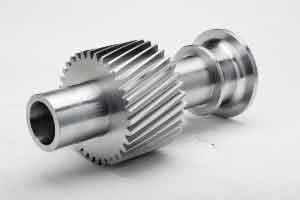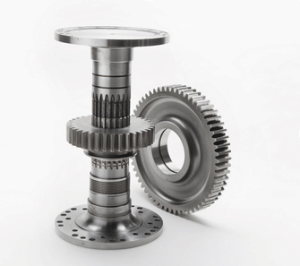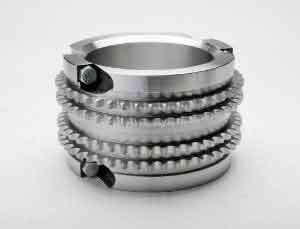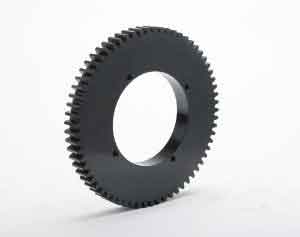There are many terms that can be used to describe different types of gears. Some terms are very common. Some you may have never heard of. In some cases, there are several different terms for describing the exact same kind of gear.
In this post, we’ve rounded up some of the terms we’ve heard used to describe the gears we make. Included with each term is a short description on what each type of gear is, and how it may relate to other similar gear terms.
We hope this round-up helps to provide some clarification to those of you who use gear terminology, whether it’s every day, or just every once in awhile.
Gear Terms
 Bevel Gear – Bevel gears, sometimes just called bevels, are cone shaped gears designed to transmit motion between intersecting axes. They are usually mounted on shafts that are 90 degrees apart, but can be designed for nearly any angle. Another related term you may here is miter gear, which is a type of bevel gear in which the mating pairs have the same number of teeth.
Bevel Gear – Bevel gears, sometimes just called bevels, are cone shaped gears designed to transmit motion between intersecting axes. They are usually mounted on shafts that are 90 degrees apart, but can be designed for nearly any angle. Another related term you may here is miter gear, which is a type of bevel gear in which the mating pairs have the same number of teeth.
Ground Gear – Ground gears are produced by the manufacturing process of gear grinding, also known as gear tooth grinding. Gear grinding produces high precision gearing, so ground gears are capable of meeting higher quality requirements (AGMA, DIN, JIS or ISO) than cut gears. Gear grinding is especially effective when gears distort during the heat treat process and tooth forms no longer meet drawing requirements. Both spur and helical gears can be produced using this method.
 Helical Gear – While the teeth on spur gears are cut straight and mounted parallel to the axis of the gear, the teeth on helical gears are cut and ground on an angle to the face of the gear. This allows the teeth to engage (mesh) more gradually so they operate more smoothly and quietly than spur gears, and can usually carry a higher load. Helical gears are also known as helix gears.
Helical Gear – While the teeth on spur gears are cut straight and mounted parallel to the axis of the gear, the teeth on helical gears are cut and ground on an angle to the face of the gear. This allows the teeth to engage (mesh) more gradually so they operate more smoothly and quietly than spur gears, and can usually carry a higher load. Helical gears are also known as helix gears.
Pinion Gear – A pinion is the smaller of two meshed gears in an assembly. Pinions gears can be either spur or helical type gears, and be either the driving or driven gear, depending on the application. Pinion gears are used in many different types of gearing systems such as ring and pinion or rack and pinion systems.
Pump Gear – A pump gear is the name for a gear used in gear pumps. They consist of both a driver and driven gear and can be either spur or helical gears. Not to be confused, the term gear pump refers to the entire pump, while pump gears refers to the gears only. Gear pumps are positive displacement pumps, meaning they pump a constant amount of fluid in each revolution. The volume of fluid in a revolution depends on the geometry of the pump gears (i.e. number of teeth, diametrical pitch, etc.).
 Spline – Splines are the ridges or teeth (external spline) on a drive shaft that mesh with an equal number of like ridges or teeth (internal spline) in a mating piece with the purpose of transferring torque from one member to the other. The most common splines are parallel key splines, involute splines (closely related to involute gears but with shorter teeth, root to tip), and serrations. Splines can be produced by shaping, hobbing or broaching.
Spline – Splines are the ridges or teeth (external spline) on a drive shaft that mesh with an equal number of like ridges or teeth (internal spline) in a mating piece with the purpose of transferring torque from one member to the other. The most common splines are parallel key splines, involute splines (closely related to involute gears but with shorter teeth, root to tip), and serrations. Splines can be produced by shaping, hobbing or broaching.
 Sprocket – Sprockets, or sprocket wheels, are toothed wheels whose teeth engage the links of chains or belts. Sprockets are distinguished from gears in that sprockets are never meshed together directly. There are several different types of sprockets, including silent chain, roller, and ladder sprockets.
Sprocket – Sprockets, or sprocket wheels, are toothed wheels whose teeth engage the links of chains or belts. Sprockets are distinguished from gears in that sprockets are never meshed together directly. There are several different types of sprockets, including silent chain, roller, and ladder sprockets.
 Spur Gear – Spur gears are the most common type of gear. They are used to transmit motion between two parallel shafts and are known for being highly efficient and producing a lot of power. Spur gears are known by quite a few other names including straight gears, straight-cut gears, spur wheels, and spur gearing. These all have the same basic definition and can be used interchangeably.
Spur Gear – Spur gears are the most common type of gear. They are used to transmit motion between two parallel shafts and are known for being highly efficient and producing a lot of power. Spur gears are known by quite a few other names including straight gears, straight-cut gears, spur wheels, and spur gearing. These all have the same basic definition and can be used interchangeably.
Timing Gear – Timing gears, as the name implies, are used for various timing purposes. Also called synchronous gears, they can be either spur or helical gears. They are often used in automotive applications to control valve timing in engines.
 Worm Gear – A worm gear consists of a worm and a worm wheel working together. The worm resembles a screw and is sometimes called a worm screw, while the worm wheel looks similar to a spur gear or helical gear with a slight helix angle. This set is sometimes also called a worm drive. Worm gears are the most compact type of gear and are often used in applications where space is limited.
Worm Gear – A worm gear consists of a worm and a worm wheel working together. The worm resembles a screw and is sometimes called a worm screw, while the worm wheel looks similar to a spur gear or helical gear with a slight helix angle. This set is sometimes also called a worm drive. Worm gears are the most compact type of gear and are often used in applications where space is limited.
Regardless of what term you use to describe your gears, the experts at China Gear Motions are ready to assist you with all of your gear manufacturing needs. Contact us with any gear related questions or to request a quote on your next gearing project.






